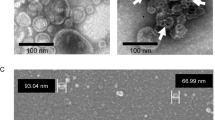Abstract
Plasma membrane modifications have been widely recognized as crucial factors in cell injury and death. One of these modifications, surface blebbing, has been considered as an injury-marker associated with a series of biochemical and physiological modifications. Our study focused on the different effects of free radical-induced cell damage by quinone menadione (2-methyl-1,4-naphthoquinone) and by hyperthermic shock (45°C) on the erythroleukemic cell line K.562. Different techniques including immunofluorescence, freeze-fracturing, and electron paramagnetic resonance spectroscopy were employed. Menadione induced the formation of surface blebs, accompanied by a rearrangement of the microfilament system and changes in the distribution of plasma membrane proteins. In contrast, heat-shocked cells showed neither blebbing nor important cytoskeletal changes. Finally, the electron paramagnetic resonance results showed an increase in membrane order not specifically related to the type of free radical-induced stress. These cell death features appear to suggest the existence of two different types ofpathways for necrotic cell death: both treatments induce cell injury and eventual death by modifiting plasma membrane integrity and function. However, one involves cytoskeleton-dependent surface blebbing, whereas the other does not.
Similar content being viewed by others
Abbreviations
- EPR:
-
electron paramagnetic resonance
- HS:
-
heat shock
- IMPs:
-
intramembrane particles
- MEN:
-
menadione
References
ALLEN, T.D. (1987). “Ultrastructural aspects of cell death.” In: Perspectives on Mammalian Cell Death (C.S. Potten, ed.). Oxford University Press, Oxford. pp. 39–65.
ARENDS, M.J. and ARENDS, R.G., WYLLIE, A.H. (1991). “Apoptosis: mechanisms and roles in pathology.” Int. Rev. Exp. Pathol. 32:223–254.
BASS, H., MOORE, J.L., and COAKLEY, W.T. (1978). “Lethality in mammalian cells due to hyperthermia under oxic and hypoxic conditions.” Int. J. Radiat. Biol. 33:57–67.
BELLOMO, G. and ORRENIUS, S. (1985). “Altered thiol and calcium homeostasis in oxidative hepatocellular injury.” Hepatology 5:876–882.
BELLOMO, G., MIRABELLI, F., VAIRETTI, M., IOSI, F., and MALORNI, W. (1990a). “Cytoskeleton as a target in menadione-induced oxidative stress in cultured mammalian cells. 1. Biochemical and immunocytochemical features.” J. Cell. Physiol. 143:118–128.
BELLOMO, G., MIRABELLI, F., RICHELMI, P., MALORNI, W., IOSI, F., and ORRENIUS, S. (1990b). “The cytoskeleton as a target in quinone toxicity.” Free Rad. Res. Commun. 8:391–399.
BOOBIS, A.R., FAWTHROP, D.J., and DAVIES, D.S. (1989). “Mechanisms of cell death. TIPS 10:275–280.
BORRELLI, M.J., WONG, R.L.L., and DEWEY, W.C. (1986). “A direct correlation between hyperthermia-induced membrane blebbing and survival in synchronous G1 CHO cells.” J. Cell Physiol. 126: 181–190.
BURDON, R.H., GILL, V., and RICE-EVANS, C. (1968). “Lipid peroxidation and cellular protein synthesis: Effects of drugs, serum deprivation and exposure to low and high temperatures.” In: Free Radicals, Oxidant Stress and Drug Action (C. Rice-Evans, ed.). Richelieu Press, London. pp. 347–361.
CERVERA, J. (1987). “Effects of thermic shock on HEp-2 cells; an ultrastructural and high resolution autoradiographic study.” J. Ultrastruct. Res. 63:51–63.
COAKLEY, W.T. (1987). “Hyperthermia effects on the cytoskeleton and on cell morphology.” In: Temperature and Animal Cellss (K. Bowler, and B.J. Fuller, eds.). The Company of Biologists Limited, Cambridge. pp. 39–65.
FRANCESCHI, C. (1989). “Cell proliferation, cell death and aging.” Aging 1:3–15.
GAFFNEY, B.J. (1975). “Fatty acid chain flexibility in the membranes of normal and transformed fibroblasts.” Proc. Natl. Acad. Sci. USA 72:664–668.
HINSHAW, D.B., SKLAR, L.A., BOHE, B., SCHRAUFSTATTER, I., HYSLOP, P.A., ROSSI, M.W., SPRAGG, R.G., and COCHRANE, C.G. (1986). “Cytoskeletal and morphologic impact of cellular oxidant injury.” Am. J. Pathol. 123:454–464.
JEWELL, S.A., BELLOMO, G., THOR, H., ORRENIUS, S., and SMITH, M.T. (1982). “Bleb formation in hepatocytes during drug metabolism is caused by disturbances in thiol and calcium ion homeostasis.” Science 217:1257–1259.
LEMASTERS, J.J., GIUSEPPI, J.D., NIEMINEN, A.L., and HERMAN, B. (1987). “Blebbing, free calcium and mitochondrial membrane potential preceding cell death in hepatocytes.” Nature 325:78–80.
MALORNI, W., FIORENTINI, C., PARADISI, S., GIULIANO, M., MASTRANTONIO, P., and DONELLI, G. (1990). “Surface blebbing and cytoskeletal changes inducedin vitro by toxin B from Clostridium difficile: an immunochemical and ultrastructural study.” Exp. Mol. Pathol. 52:340–356.
MARCOCCI, L. and MONDOVì, B. (1990). “Biochemical and ultrastructural changes in the hyperthermic treatment of tumor cells: an outline.” In: Consensus on Hyperthermia for 1990 (H.I. Bicher, J.R. McLaren, and G.M. Pigliucci, eds.). Plenum Press, New York, pp. 99–120.
MIRABELLI, F., SALIS, A., PEROTTI, M., TADDEI, F., BELLOMO, G., and ORRENIUS, S. (1988). “Alterations of surface morphology caused by the metabolism of menadione in mammalian cells are associated with the oxidation of critical sulfhydryl groups in cytoskeletal proteins.” Biochem. Pharmacol. 37:3423–3427.
ORRENIUS, S., McCONKEY, D.J., BELLOMO, G., and NICOTERA, P. (1989). “Role of calcium in toxic cell killing.” TIPS 10:281–285.
SANTINI, M.T., INDOVINA, P.L., and HAUSMAN, R.E. (1987). “Changes in myoblast membrane order during differentiation as measured by EPR.” Biochim. Biophys. Acta 896:19–25.
SATO, C., and YONEI, S. (1987). “Membrane changes.” In: Perspectives on Mammalian Cell Death (C.S. Potten, ed.). Oxford University Press, Oxford. pp. 1–17.
TRUMP, B.F., BEREZESKY, I.K., SMITH, M.W., PHELPS, P.C., and ELLIGET, K.A. (1989). “The relationship between cellular ion deregulation and acute and chronic toxicity.” Toxicol. Appl. Pharmacol. 97:6–22.
VIDAIR, C.A. and DEWEY, W.C. (1988). “Two distinct modes of hyperthermic cell death.” Radiat. Res. 116:157–171.
WALKER, N.I., HARMON, B.V., GOBE, G.C., and KERR, J.F.R. (1988). “Patterns of cell death.” Meth. Achiev. Exp. Pathol. 13:18–54.
Author information
Authors and Affiliations
Rights and permissions
About this article
Cite this article
Malorni, W., Paradisi, S., Iosi, F. et al. Two different pathways for necrotic cell death induced by free radicals. Cell Biol Toxicol 9, 119–130 (1993). https://doi.org/10.1007/BF00757574
Issue Date:
DOI: https://doi.org/10.1007/BF00757574




